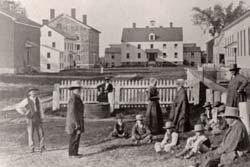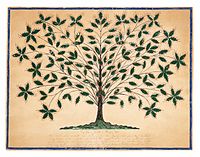
The United Society of Believers in Christ's Second Appearing, more commonly known as the Shakers, are a millenarian restorationist Christian sect founded c. 1747 in England and then organized in the United States in the 1780s. They were initially known as "Shaking Quakers" because of their ecstatic behavior during worship services.

Watervliet is a city in northeastern Albany County, New York, United States. The population was 10,375 as of the 2020 census. Watervliet is north of Albany, the capital of the state, and is bordered on the north, west, and south by the town of Colonie. The city is also known as "the Arsenal City".

Colonie is a town in Albany County, New York, United States. It is the most-populous suburb of Albany, and is the third-largest town in area in Albany County, occupying approximately 11% of the county. Several hamlets exist within the town. As of the 2020 census, the town had a total population of 85,590.

Ann Lee, commonly known as Mother Ann Lee, was the founding leader of the Shakers, later changed to United Society of Believers in Christ's Second Appearing following her death. She was born during a time of the Evangelical revival in England, and became a figure that greatly influenced religion at this time, especially in the Americas.

Seed companies produce and sell seeds for flowers, fruits and vegetables to commercial growers and amateur gardeners. The production of seed is a multibillion-dollar global business, which uses growing facilities and growing locations worldwide. While most of the seed is produced by large specialist growers, large amounts are also produced by small growers who produce only one to a few crop types. The larger companies supply seed both to commercial resellers and wholesalers. The resellers and wholesalers sell to vegetable and fruit growers, and to companies who package seed into packets and sell them on to the amateur gardener.

Shaker furniture is a distinctive style of furniture developed by the United Society of Believers in Christ's Second Appearing, commonly known as Shakers, a religious sect that had guiding principles of simplicity, utility and honesty. Their beliefs were reflected in the well-made furniture of minimalist designs.

The Old Ship Church is a Puritan church built in 1681 in Hingham, Massachusetts. It is the only surviving 17th-century Puritan meetinghouse in the United States. Its congregation, gathered in 1635 and officially known as First Parish in Hingham, occupies the oldest church building in continuous ecclesiastical use in the country. On October 9, 1960, it was designated a National Historic Landmark, and on November 15, 1966, it was added to the National Register of Historic Places.

The Era of Manifestations was a period from 1837 to the mid-1850s when Shakers came under a spiritual revival marked by visions and ecstatic experiences among the followers. They expressed their visions in song, dance and drawings.
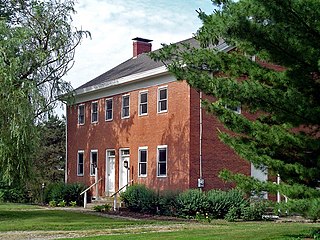
The Whitewater Shaker Settlement is a former Shaker settlement near New Haven in Crosby Township, Hamilton County, Ohio, United States. Established in 1824 and closed in 1916, it was listed on the National Register of Historic Places in 1974 as a historic district.

Mount Lebanon Shaker Society, also known as New Lebanon Shaker Society, was a communal settlement of Shakers in New Lebanon, New York. The earliest converts began to "gather in" at that location in 1782 and built their first meetinghouse in 1785. The early Shaker Ministry, including Joseph Meacham and Lucy Wright, the architects of Shakers' gender-balanced government, lived there.

Hancock Shaker Village is a former Shaker commune in Hancock and Pittsfield, Massachusetts. It emerged in the towns of Hancock, Pittsfield, and Richmond in the 1780s, organized in 1790, and was active until 1960. It was the third of nineteen major Shaker villages established between 1774 and 1836 in New York, New England, Kentucky, Ohio and Indiana. From 1790 until 1893, Hancock was the seat of the Hancock Bishopric, which oversaw two additional Shaker communes in Tyringham, Massachusetts, and Enfield, Connecticut.
Isaac Newton Youngs was a member of the Shakers. He was a prolific scribe, correspondent, and diarist who documented the history of the New Lebanon, New York Church Family of Shakers from 1815 to 1865.

Sabbathday Lake Shaker Village is a Shaker village near New Gloucester and Poland, Maine, in the United States. It is the last active Shaker community, with two members as of 2022. With a new member, it had expanded to three members by 2021. The community was established in either 1782, 1783, or 1793, at the height of the Shaker movement in the United States. The Sabbathday Lake meetinghouse was built in 1794. The entire property was declared a National Historic Landmark in 1974.
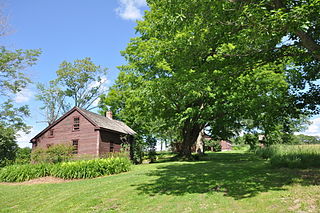
Shaker Farm is a historic farmstead on Dublin Road in Richmond, Massachusetts. The property is notable as the subject of a book by the Andrewses, The Fruits of the Shaker Tree of Life, in which they document the property's condition and restoration. The farmhouse was built c. 1795 by Daniel Hand of New Lebanon, New York, and exhibits a number of examples of Shaker craftsmanship. The Andrewses acquired the property in 1937, and devoted the rest of their lives to collecting, documenting, and promoting Shaker heritage. The property was listed on the National Register of Historic Places in 1995. As of 1995, the property continues to be owned by Andrews descendants.

Alfred Shaker Historic District is a historic district in Alfred, Maine, with properties on both sides of Shaker Hill Road. The area had its first Shaker "believers" in 1783 following visiting with Mother Ann Lee and became an official community starting in 1793 when a meetinghouse was built. It was home to Maine's oldest and largest Shaker community. Two notable events were the songwriting of Joseph Brackett, including, according to most accounts, Simple Gifts, and the spiritual healing of the sick by the Shakers. When the Alfred Shakers products and goods were no longer competitive with mass-produced products and the membership had dwindled significantly, the village was closed in 1931 and members moved to Sabbathday Lake Shaker Village, also in Maine.
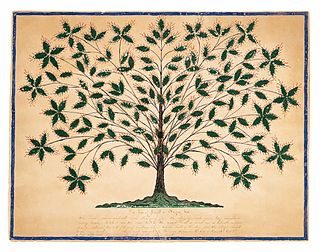
The chronology of Shakers is a list of important events pertaining to the history of the Shakers, a denomination of Christianity. Millenarians who believe that their founder, Ann Lee, experienced the Second Coming of Jesus Christ, the Shakers practice celibacy, confession of sin, communalism, ecstatic worship, pacifism, and egalitarianism. This spans the emergence of denomination in the mid-18th century, the emigration of the Shakers to New York on the eve of the American Revolution, subsequent missionary work and the establishment of nineteen major planned communities, and the continued persistence of the faith through decline into the 21st century.

The Shakers are a sect of Christianity which practices celibacy, communal living, confession of sin, egalitarianism, and pacifism. After starting in England, it is thought that these communities spread into the cotton towns of North West England, with the football team of Bury taking on the Shaker name to acknowledge the Shaker community of Bury. The Shakers left England for the English colonies in North America in 1774. As they gained converts, the Shakers established numerous communities in the late-18th century through the entire 19th century. The first villages organized in Upstate New York and the New England states, and, through Shaker missionary efforts, Shaker communities appeared in the Midwestern states. Communities of Shakers were governed by area bishoprics and within the communities individuals were grouped into "family" units and worked together to manage daily activities. By 1836 eighteen major, long-term societies were founded, comprising some sixty families, along with a failed commune in Indiana. Many smaller, short-lived communities were established over the course of the 19th century, including two failed ventures into the Southeastern United States and an urban community in Philadelphia, Pennsylvania. The Shakers peaked in population by the 1840s and early 1850s, with a membership between 4,000 and 9,000. Growth in membership began to stagnate by the mid 1850s. In the turmoil of the American Civil War and subsequent Industrial Revolution, Shakerism went into severe decline. As the number of living Shakers diminished, Shaker communes were disbanded or otherwise ceased to exist. Some of their buildings and sites have become museums, and many are historic districts under the National Register of Historic Places. The only active community is Sabbathday Lake Shaker Village in Maine, which is composed of at least three active members.

The Shaker Seed Company was an American seed company that was owned and operated by the Shakers in the eighteenth and nineteenth century. In the latter part of the eighteenth century, many Shaker communities produced several vegetable seed varieties for sale. The company created innovations in the marketing of seeds – including distributing, packaging and cataloging – all of which changed the horticultural business model forever.
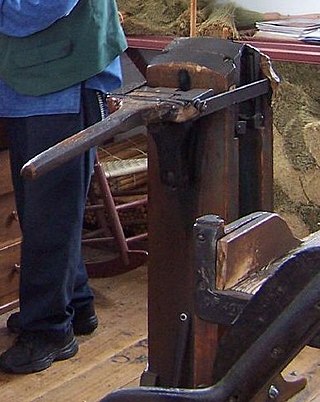
The Shaker broom vise is a specialized production vise that made the normally round broom flat to make it more efficient for cleaning purposes. The Shakers' invention revolutionized the production and form of brooms; in the process greatly expanding an industry in New England.

Edward Deming Andrews was an American historian, educator, curator, and preeminent authority on the United Society of Believers in Christ's Second Appearing, or the Shakers.
